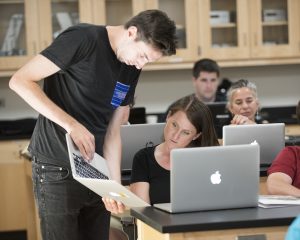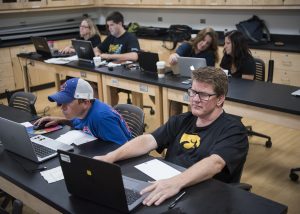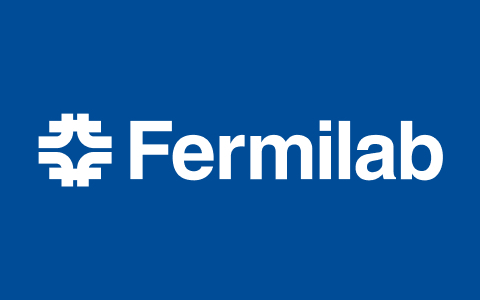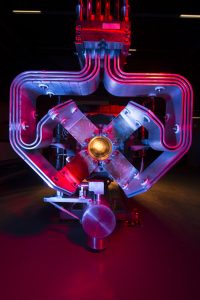Neutrinos are tricky. Although trillions of these harmless, neutral particles pass through us every second, they interact so rarely with matter that, to study them, scientists send a beam of neutrinos to giant detectors. And to be sure they have enough of them, scientists have to start with a very concentrated beam of neutrinos.
To concentrate the beam, an experiment needs a special device called a neutrino horn.
An experiment’s neutrino beam is born from a shower of short-lived particles, created when protons traveling close to the speed of light slam into a target. But that shower doesn’t form a tidy beam itself: That’s where the neutrino horn comes in.
Once the accelerated protons smash into the target to create pions and kaons — the short-lived charged particles that decay into neutrinos — the horn has to catch and focus them by using a magnetic field. The pions and kaons have to be focused immediately, before they decay into neutrinos: Unlike the pions and kaons, neutrinos don’t interact with magnetic fields, which means we can’t focus them directly.
Without the horn, an experiment would lose 95 percent of the neutrinos in its beam. Scientists need to maximize the number of neutrinos in the beam because neutrinos interact so rarely with matter. The more you have, the more opportunities you have to study them.
“You have to have tremendous numbers of neutrinos,” said Jim Hylen, a beam physicist at Fermilab. “You’re always fighting for more and more.”
Also known as magnetic horns, neutrino horns were invented at CERN by the Nobel Prize-winning physicist Simon van der Meer in 1961. A few different labs used neutrino horns over the following years, and Fermilab and J-PARC in Japan are the only major laboratories now hosting experiments with neutrino horns. Fermilab is one of the few places in the world that makes neutrino horns.
“Of the major labs, we currently have the most expertise in horn construction here at Fermilab,” Hylen said.
How they work
The proton beam first strikes the target that sits inside or just upstream of the horn. The powerful proton beam would punch through the aluminum horn if it hit it, but the target, which is made of graphite or beryllium segments, is built to withstand the beam’s full power. When the target is struck by the beam, its temperature jumps by more than 700 degrees Fahrenheit, making the process of keeping the target-horn system cool a challenge involving a water-cooling system and a wind stream.
Once the beam hits the target, the neutrino horn directs resulting particles that come out at wide angles back toward the detector. To do this, it uses magnetic fields, which are created by pulsing a powerful electrical current — about 200,000 amps — along the horn’s surfaces.
“It’s essentially a big magnet that acts as a lens for the particles,” said physicist Bob Zwaska.
The horns come in slightly different shapes, but they generally look on the outside like a metal cylinder sprouting a complicated network of pipes and other supporting equipment. On the inside, an inner conductor leaves a hollow tunnel for the beam to travel through.
Because the current flows in one direction on the inner conductor and the opposite direction on the outer conductor, a magnetic field forms between them. A particle traveling along the center of the beamline will zip through that tunnel, escaping the magnetic field between the conductors and staying true to its course. Any errant particles that angle off into the field between the conductors are kicked back in toward the center.
The horn’s current flows in a way that funnels positively charged particles that decay into neutrinos toward the beam and deflects negatively charged particles that decay into antineutrinos outward. Reversing the current can swap the selection, creating an antimatter beam. Experiments can run either beam and compare the data from the two runs. By studying neutrinos and antineutrinos, scientists try to determine whether neutrinos are responsible for the matter-antimatter asymmetry in the universe. Similarly, experiments can control what range of neutrino energies they target most by tuning the strength of the field or the shape or location of the horn.
Making and running a neutrino horn can be tricky. A horn has to be engineered carefully to keep the current flowing evenly. And the inner conductor has to be as slim as possible to avoid blocking particles. But despite its delicacy, a horn has to handle extreme heat and pressure from the current that threaten to tear it apart.
“It’s like hitting it with a hammer 10 million times a year,” Hylen said.
Because of the various pressures acting on the horn, its design requires extreme attention to detail, down to the specific shape of the washers used. And as Fermilab is entering a precision era of neutrino experiments running at higher beam powers, the need for the horn engineering to be exact has only grown.
“They are structural and electrical at the same time,” Zwaska said. “We go through a huge amount of effort to ensure they are made extremely precisely.”

Fermilab postdoc Ben Kreis explains to TRAC teacher Elizabeth Wenk how to navigate through the CMS event display software during a teacher workshop at Waubonsee Community College. Photo: Waubonsee Community College
At the Waubonsee Community College campus in Sugar Grove, Illinois, a group of 22 high school and middle school teachers gathered in pairs to pore over data from CERN’s CMS experiment. Over the course of two hours, they classified more than 100 particle physics events, graphed their data and measured the mass of fundamental particles. As schools are gearing back up for the academic year, these teachers will be able to think about how to bring these real-world science experiences into the classroom.
“I want my students to understand the current questions scientists are working on answering and how they are trying to answer them,” teacher Amanda Whaley said.
Whaley is one of seven high school and middle school teachers who attended the Teacher Research Associates, or TRAC, program located at and funded by Fermilab. TRAC has existed since 1983, but in recent years it has taken on an emphasis on turning those lab experiences into lessons or exercises for students. The two-day workshop in Sugar Grove, organized by TRAC in July and funded by U.S. CMS, brought in not just the program’s participants but also 16 teachers from the local area, educating them about models of different physics lessons and information about the frontier of particle physics research.
The TRAC program itself is a roughly eight-week internship program that paired teachers with mentors at Fermilab to gain experience working in a real physics lab setting. The teachers, who could come from any area of science, math, computer science or technology, each contributed individually to projects around the lab.
Harry Cheung, the head of the program since 2010, said the purpose of TRAC as one of Fermilab’s outreach programs is to educate teachers about what happens at physics labs so students can learn about the real-life applications of the subject matter.

Former TRAC teacher Jeff Van Harlingen, left, and current TRAC teacher Jeff Breiten scan through CMS events to categorize them for an exercise at a teacher workshop at Waubonsee Community College. Photo: Waubonsee Community College
“They get concrete examples of how something is useful,” he said. “They get to talk about the things they’ve done here.”
The teachers were able to jump into major projects at the lab. Whaley worked on research and development for a proposed upgrade to the CMS forward hadron calorimeter, which measures the energy of some particles and detects the presence of others. Another teacher worked on a hand-scanned particle event display study for Fermilab’s NOvA neutrino experiment. Another worked on data acquisition for detectors.
Some of the teachers said their experience in the labs reminded them of skills students will need if they choose fields in science. Whaley said she wants to be sure her students can defend their conclusions when pressed. Another teacher, Elizabeth Wenk, was surprised by the amount of time scientists spent in meetings or writing. She plans to emphasize lab reports and communication more in her class.
And several teachers said they gained fresh perspectives on what it’s like to be a student in physics.
“I’ve been teaching the same material for such a long time,” Wenk said. “I have a newfound appreciation and understanding of students who struggle.”
Particle physics can be difficult to incorporate into a standard curriculum, particularly for middle school teachers. But some can use the material in independent study courses or in more advanced physics classes. Chemistry teachers can go from teaching about molecular scales to even smaller ones when teaching students about atoms. And others have thought of less conventional outlets, such as extracurricular programs.
“I’m really excited about trying out the new things I learned,” Wenk said. “It’s really going to change how I think, and it’s going to have a big impact on the students.”

